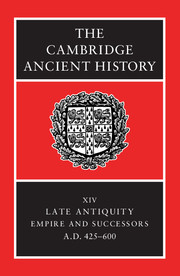Book contents
- Frontmatter
- PART I CHRONOLOGICAL OVERVIEW
- PART II GOVERNMENT AND INSTITUTIONS
- PART III EAST AND WEST: ECONOMY AND SOCIETY
- PART IV THE PROVINCES AND THE NON-ROMAN WORLD
- PART V RELIGION AND CULTURE
- 24 The organization of the church
- 25 Monasticism
- 26 Holy Men
- 27 The definition and enforcement of orthodoxy
- 28 Philosophy and philosophical schools
- 29 Education in the Roman empire
- 30 The visual arts
- 31 Building and architecture
- Conclusion
- Chronological Table
- BIBLIOGRAPHY
- Index
- References
25 - Monasticism
from PART V - RELIGION AND CULTURE
Published online by Cambridge University Press: 28 March 2008
- Frontmatter
- PART I CHRONOLOGICAL OVERVIEW
- PART II GOVERNMENT AND INSTITUTIONS
- PART III EAST AND WEST: ECONOMY AND SOCIETY
- PART IV THE PROVINCES AND THE NON-ROMAN WORLD
- PART V RELIGION AND CULTURE
- 24 The organization of the church
- 25 Monasticism
- 26 Holy Men
- 27 The definition and enforcement of orthodoxy
- 28 Philosophy and philosophical schools
- 29 Education in the Roman empire
- 30 The visual arts
- 31 Building and architecture
- Conclusion
- Chronological Table
- BIBLIOGRAPHY
- Index
- References
Summary
Devotion to asceticism was a highly visible and in some ways alarming feature of the late Roman world. That thousands of men and women were ready to adopt a life of radical simplicity, sexual abstinence and apparent indifference to wealth, status and power, and that even larger numbers were willing to admire if not imitate their choice, tells us something remarkable about the society in which they lived. Restrictions in diet and sexual behaviour had been accepted for centuries; and abnegation was frequently accompanied by a rejection of influence in public affairs and of privilege and property. Christians, however, from the third century onwards, were responsible for an unprecedented upsurge in ascetic devotion. The movement transformed town as well as countryside: famous exemplars may have congregated at first in remoter districts; but a new class of citizen became more widely evident at an early stage. Distinguished at times by an appalling emaciation of the body, by filth and infestation, by ragged, colourless and skimpy clothes, large numbers of these ascetics converged, at moments of crisis, on the cities themselves, forming virtual mobs that were capable not only of menace but of real power. Within a relatively short time, they occupied special and prominent buildings, administered successful rural estates, broadcast their views in public fora, and gained the ear of those in power – invading, in other words, the chief components of the late Roman polity.
- Type
- Chapter
- Information
- The Cambridge Ancient History , pp. 745 - 780Publisher: Cambridge University PressPrint publication year: 2001

